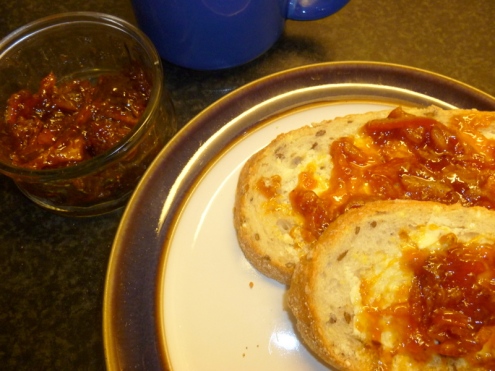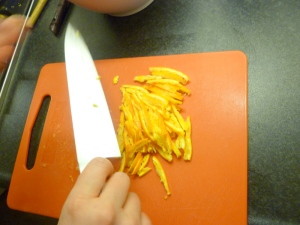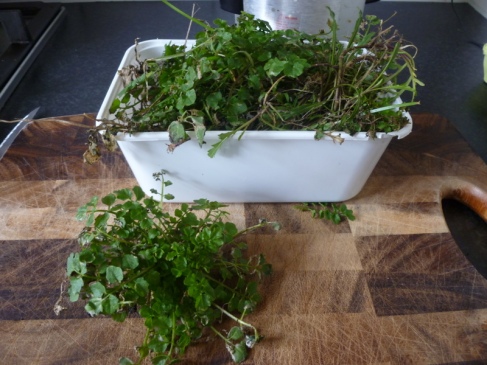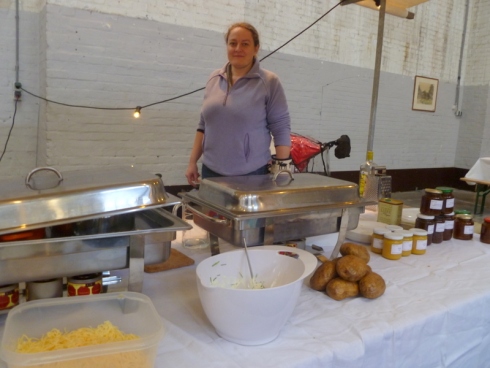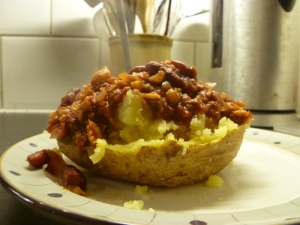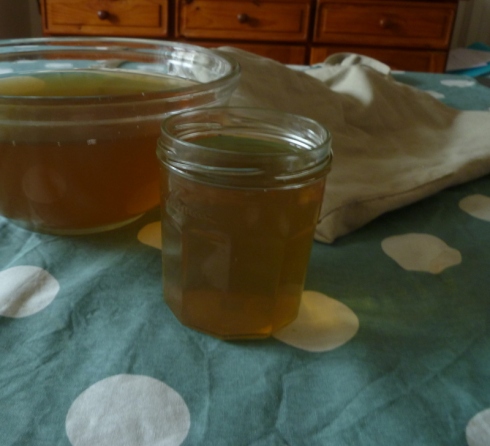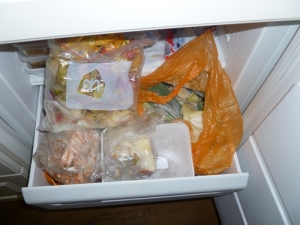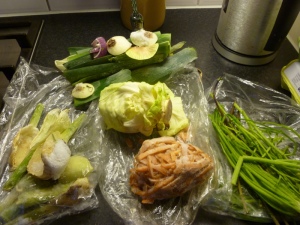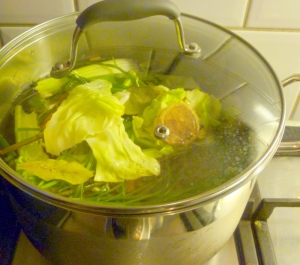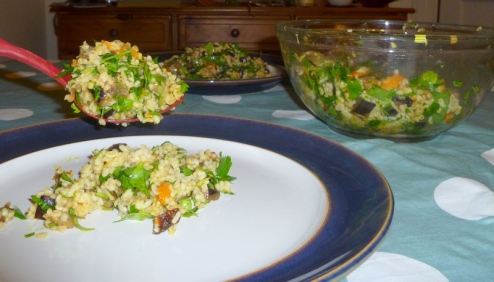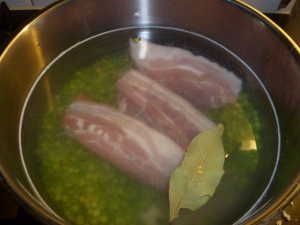The clementine marmalade I made caught slightly on the bottom of the pan. This is what comes of trying to cook and blog at the same time! I only took my eye off the ball for a couple of seconds, while I had a spoonful of the golden, orangey preserve waiting for the fridge test.
Most of the marmalade was fine, so I bottled it up. But there was about half a jar on the bottom which had gone too far. As you know, I cannot bear to waste food, and this is no exception. I won’t inflict this on my friends, but there is no reason why I can’t still use it.
Marmalade makes a great glaze for both sweet and savoury food. I did bake a yoghurt cake, and then melted 2 tbsp of the marmalade with a tbsp of water to make a glaze. I poured the glaze over the cake while both were still warm, and then left the lot to cool in the tin. Unfortunately, I have never made a yoghurt cake before, and clearly didn’t beat the egg, yoghurt and oil together enough, so it was too dense, so I haven’t photographed it. It was fine, when splashed with a little Cointreau (or orange juice would also be fine), and served with fresh Greek yoghurt.
I have also kept a little marmalade in reserve, because I have another glaze in mind, but this time for a nice duck, a wild one if I can get hold of it. I shall add shallots and thyme, and make sure I baste the bird as it cooks. I guess you can expect to see it here, if it is a success.
However, I left the lion’s share of the leftover marmalade for the recipe I am about to share with you now. The first thing that came to my mind when it was clear I would have some marmalade was flapjacks. I’m not really sure why, but I knew that I had to try it. I had a feeling that the thick cut, sticky marmalade would be the perfect foil for the oats. Both of them are traditionally associated with breakfast, and I really thought this could fly. I thought about it some more over the next few days, and it became clear that I could substitute the marmalade for the usual golden syrup.
There is a golden ratio for the usual kind of flapjack. As long as you stick with this ratio, then you can’t go far wrong. It also works for metric, imperial, volume, or if you prefer to measure your ingredients by a more eccentric means. The ratio is as follows:
- 2 Golden Syrup
- 4 Butter
- 6 Brown Sugar
- 8 Oats (or oats & other dry ingredients, such as seeds)
This is the ratio that I was taught as a small kid, and it has never yet done me wrong. You can then add more stuff, like dried or fresh fruits, candied peel or crystallised ginger, spices, chocolate, and so on. I always use a mix of whole rolled oats, and the finer, chopped sort that is best for porridge, because I find this gives it a better texture without falling apart. You can add seeds and other grains as well if you like, but you should adjust the amount of oats, so that you maintain the ratio.
These were unconventional flapjacks, not just in the sense of substituting syrup for marmalade, but I have to admit in this case, I also decided to adjust the proportions of the ratio as well. I wanted the orange to really shine in the mix, and the marmalade has a lot of sugar in it anyway. It may not please your grandmother, but it worked for me in this instance.
After a bit of fiddling, I settled on a 4:4:4:8 ratio, and the results worked really well. The bars are chewy, albeit in a slightly different, stickier way than regular golden syrup ones, but I like it.
I prefer my flapjacks on the chewier side, but if you are one of those people who like crunchier flapjacks, you may need to add some golden syrup, or possibly more butter to prevent the marmalade making the bar too hard in the (slightly) longer cooking process. It is not something that I experimented with this time, but I would be happy to if others are interested. You don’t have to use up marmalade mistakes – ordinary marmalade from a jar will do just as well here.
The amounts I am going to give were enough for a 20 x 25 cm tin. I tend to line my tins with baking paper, because it makes the finished flapjacks a lot easier to remove from the tin, but you can just grease the tin really well, it is up to you. If I were a more dedicated baker, I would invest in that reuseable silicon parchment stuff, to reduce waste. I have got a birthday coming up, so who knows?
Recipe: Breakfast Flapjacks
Ingredients
160 g marmalade
160 g butter
160 g brown sugar (I used light muscovado and demerara, because it is what I had)
300 g mix of whole and chopped rolled oats
30 g pumpkin seeds
30 g dried cranberries
Method
Put your oven on at 180 °C.
Melt the marmalade, butter, and sugar over a medium heat, stirring so they don’t catch on the bottom of the pan.
Mix the oats, pumpkin seeds, and cranberries in a large bowl.
When the sweet goods and the butter have all melted and combined together well, pour onto the dried ingredients, and mix well to ensure that they are all well coated and no streaks of white oats remain.
Press the flapjack mix into the baking tray. You want to press it in fairly well, to help the mixture set into lovely bars. Then smooth it over with the back of a metal spoon, making the top smooth, and the flapjack layer as even as you can.
Bake it for about 25-30 minutes, depending on how chewy or crunchy you want it. Flapjacks are really forgiving, so they are easy to cook with other things, to maximise your energy use from the oven. They won’t collapse if you open your oven at the wrong time, and don’t really absorb other flavours. I haven’t tried cooking them at the same time as smoked fish, for example, but they are fine t go in with stews, other cakes, roasting meat etc.
When they are nice and golden all over, then remove them from the oven. You will need to mark them into the squares or rectangles that you intend to serve them in fairly soon after coming out of the oven. I got 12 bars from this amount of mixture. Then they should be allowed to cool completely in the baking tray.
These flapjacks are really tasty, and the pieces of orange and cranberry really do add an interesting texture, as well as the marmalade, giving them a bit more kick than your average flapjack. Marmalade – it’s not just for toast, you know!


